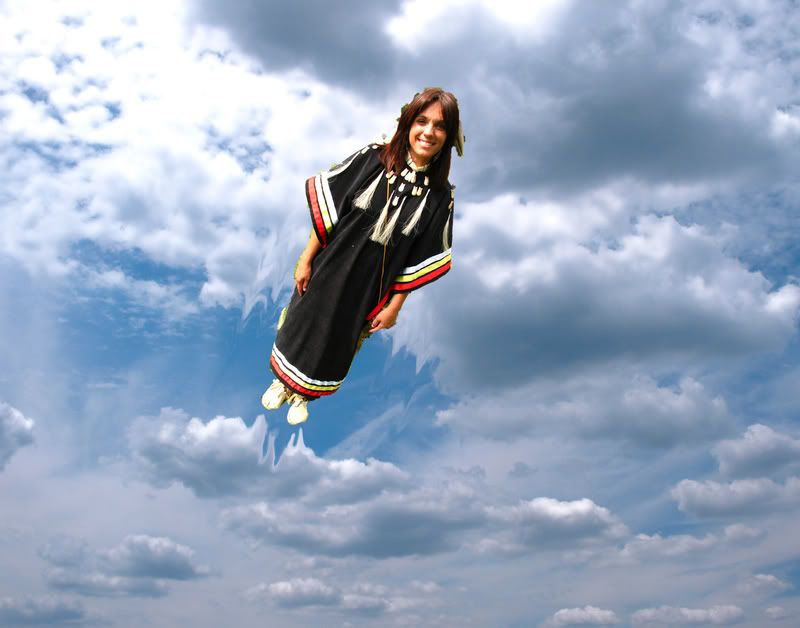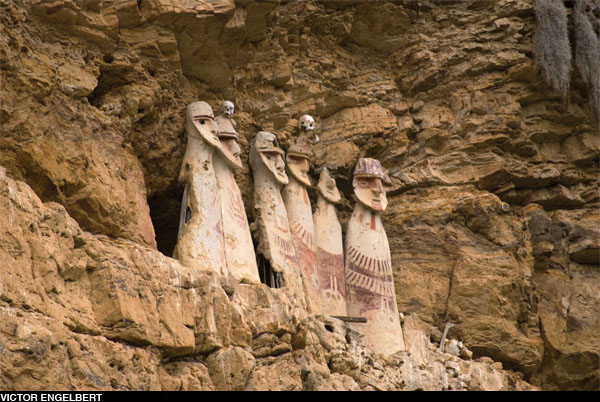
Buildings carved into the Pachallama peak mountainside in Peru, by Chachapoya
Posted on 12/03/2008 4:58:17 PM PST by bruinbirdman
Archaeologists have discovered a lost city carved into the Andes Mountains by the mysterious Chachapoya tribe.
The settlement covers some 12 acres and is perched on a mountainside in the remote Jamalca district of Utcubamba province in the northern jungles of Peru's Amazon.

Buildings carved into the Pachallama peak mountainside in Peru, by Chachapoya
The buildings found on the Pachallama peak are in remarkably good condition, estimated to be over 1,000 years old and comprised of the traditional round stone houses built by the Chachapoya, the 'Cloud Forest People'.
The area is completely overgrown with the jungle now covering much of the settlement but explorers found the walls of the buildings and rock paintings on a cliff face.
The remote nature of the site appears to have protected the site from looters as archaeologists found ceramics and undisturbed burial sites.
Archaeologist Benedicto Pérez Goicochea said: "The citadel is perched on the edge of an abyss.
"We suspect that the ancient inhabitants used this as a lookout point from where they could spot potential enemies."
The ruins were initially discovered by local people hacking through the jungle. They were drawn to the place due to the sound of a waterfall.
The local people "armed with machetes opened a path that arrived at the place where they saw a beautiful panorama, full of flowers and fauna, as well as a waterfall, some 500 metres high," said the mayor of Jamalca, Ricardo Cabrera Bravo.
Initial studies have found similarities between the new discovery and the Cloud Peoples' super fortress of Kulep, also in Utcubamba province, which is older and more extensive that the Inca Citadel of Machu Picchu, but has not been fully explored or restored.
Little is known about the Chachapoya, except that they had been
(Excerpt) Read more at telegraph.co.uk ...



yitbos
Apparently their society ran out of vowels.


The mysterious super fortress of the Chachapoyan Cloud People


Do they know that from decoration on the bowl, or from residue inside it? I didn’t know that psilocybin mushrooms grew in the Andes region (of course, I don’t really know that much about them at all, just thought they were from North America).
|
|
|||
Gods |
Thanks ferri. |
||
|
· Discover · Nat Geographic · Texas AM Anthro News · Yahoo Anthro & Archaeo · · The Archaeology Channel · Excerpt, or Link only? · cgk's list of ping lists · |
|||
Just be glad it wasn't...

However, the vessel in Indianapolis was clearly marked with everything you'd need to know about Amanita Muscaria (which is "psychoactive" if and only if it's grown in Northern Eur-Asia, or high in the Himalayas.
Yup, we thought it was strange to find something like that being manufactured WAYBACK before Europeans were known to visit South America.
“Very interesting. They look similar to the cliff dwellings at Mesa Verde in SW Colorado.”
I was thinking the same thing, but how it looked similar to Montezuma’s castle, or the cliff dwellings in Canyon de Chelly in Arizona.
Flying hippies.
 While some Chachapoya elite were buried in standing clay and grass effigies, as at Karijia, others were entombed in chullpas, brightly painted cliffside tombs, such as those found at the site of Revash. Painted in shades of red and cream, many of the chullpas have gabled roofs and are embellished with cross-shaped niches. Local farmers call the red markings and targetlike circles ojos, or eyes--ancestors keeping tabs on the living.
While some Chachapoya elite were buried in standing clay and grass effigies, as at Karijia, others were entombed in chullpas, brightly painted cliffside tombs, such as those found at the site of Revash. Painted in shades of red and cream, many of the chullpas have gabled roofs and are embellished with cross-shaped niches. Local farmers call the red markings and targetlike circles ojos, or eyes--ancestors keeping tabs on the living.

On a cliff ledge overlooking the vast Utcubamba Valley I spot five-foot-tall anthropomorphic sarcophagi of six ancient Chachapoya, gazing at the rising sun, as if the dead were watching over the living. The capsulelike coffins, made of clay and grass, and built into the cliff face between A.D. 1100 and 1300, are shielded from the rain by overhanging rock. Within them are mummy bundles holding the remains of Chachapoya elite. To reach the cliff heights, the Chachapoya may have used natural ledges, which were destroyed when they withdrew. Scholars believe a stone wall was erected around each mummy bundle. Cane poles were inserted into the walls, sort of teepee-style, and the capsules were built up and then painted. The effigies were finally "dressed" in feathered tunics and adorned with necklaces and trophy heads. The skulls may have been part of the decoration. The site is called Karijia, after a canyon below; the sarcophagi are known to locals as "ancient wise men."

It may not be Machu Picchu, but the Kuelap citadel, the largest Chachapoya fortress-city by far, is an impressive place built more than 1,000 years ago. Protected on one side by a sheer drop, it stands at an elevation of 9,500 feet and is surrounded by a dense forest. A 65-foot wall of pale yellow stones surrounds some 420 houses and ceremonial structures, many of them still buried under trees and vegetation that include colorful bromeliads and orchids. Three funnel-like entrances further protected the site from intruders. Many of the walls within the 15-acre fortress display friezes that may be stylized eyes of a puma, one of the Chachapoya's four animal deities. With some 3,500 inhabitants at its height, Kuelap (the name suggests a fortified settlement) was a big town for its time. While it was known to the Spanish, who collected tribute from the people who lived there, the first archaeological investigation of the site was carried out by an Italian, Antonio Raimondi, in 1860.

Utcubamba Valley
Interesting. So it was the markings on the vessel that told the story. Looks like they were smart enough to “label” their stash so it wouldn’t get mistaken for something else. ;-)
You be upchucking a long time Fur Shur.
The sarcophagi statuary looks remarkably Viking ~ see:
http://viking-nevo.narod.ru/images/games/skiing-vikings.gif
Thanks!
Whew!
Disclaimer: Opinions posted on Free Republic are those of the individual posters and do not necessarily represent the opinion of Free Republic or its management. All materials posted herein are protected by copyright law and the exemption for fair use of copyrighted works.